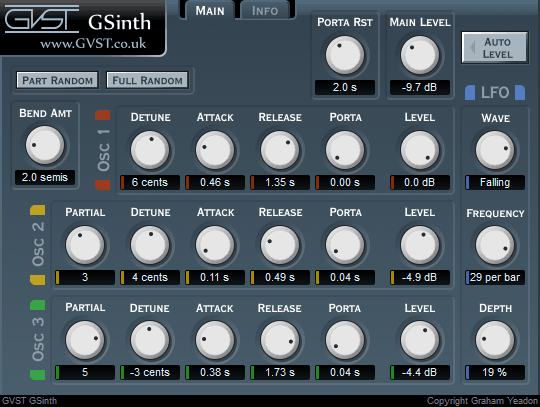GSinth Manual
Welcome to GSinth
GSinth is a monophonic VSTi with three sine oscillators. It also features an LFO for controlling the output level.
Installation
- All GVST plug-ins come compressed in a ZIP file, so the first step is to extract the files from the ZIP file.
- Once extracted, you should have one or more DLL files, these are the plug-in files.
- You need to copy the plug-in files to the appropriate folder for your host program.
- In most cases, you will need either to restart the host program or re-scan the plug-in folder in order for newly-installed plug-ins to appear.
Hints
- Each oscillator has its own "Attack" and "Portamento" setting, allowing interesting, evolving sounds to be created.
- The best way to get a feeling for GSinth is by using the "Random" button and then tweaking the parameters.
- The "Random" button can create extremely inharmonic sounding settings because of the "Detune" parameters. Holding down "Shift" while clicking on the "Random" button creates better-behaved presets.
Interface

Each knob is laid out the same way for consistent and easy reference. Above each one, its function is labelled. Below each one is a numerical readout of the value assigned. There are also two buttons to aid configuration, "Random" and "AutoLevel".
Oscillator Controls
Many parameters are repeated for each oscillator, e.g. "Cent", "Attk", etc. Each of these parameters will be described only once below.
Partial: This controls the frequency of the oscillator. The first oscillator is fixed to play at the frequency implied by the depressed MIDI key. The remaining two oscillators play at a multiple of that frequency, set by this parameter.
Detune: This allows each oscillator to be detuned by up to a semitone (100 cents) sharp or flat. Attk and Rel: Defines the envelope of the oscillator, i.e. the time taken to reach full volume after a key is pressed and the time taken to reach silence after the key is released.
Porta: Controls the portamento of the oscillator, i.e. the time taken for the oscillator to "slide" from one note to the next.
Level: The level of the oscillator.
LFO Controls
The LFO is used to modulate the overall output level. It is synchronised to the start of each bar. Three parameters describe the LFO shape, frequency and the modulation depth.
LFOWave: The wave-shape of the LFO, e.g. Sine.
LFOFreq: The frequency of the LFO in cycles per bar.
LFODepth: How much the LFO will affect the output level.
Global Controls
The remaining parameters affect the overall sound.
PtchBend: The maximum pitch-bend caused by the pitch-bend wheel.
PortaRst: After this time has passed the portamento is reset. Once the portamento is reset, the next note played will simply play at the implied frequency, without "sliding" from the previously played note.
MainLvl: The output level.
Random: Pressing the random button will randomize all of the parameters apart from "PtchBend", "PortaRst", and "MainLvl". After randomization, the "MainLvl" parameter is set automatically, as if the "AutoLevel" button were pressed.
AutoLevel: Sets the "MainLvl" parameter so that the peak output level does not exceed -3 dB.
License
- GVST plug-ins are provided to the user at no cost. While every GVST plug-in is tested to the best of the developer's ability, no warranty or guarantee is offered to the end user.
- No suggestions made by the developer or his representatives (i.e., freely offered support) are to be taken as an implied warranty or guarantee.
- These plug-ins may only be distributed by the official GVST website, or by parties explicitly given permission by the developer.
- GVST plug-ins are to be distributed only in their original form as intended by the developer (i.e., the unaltered archive).
- GVST plug-ins are freeware, meaning you are never under any obligation to pay for them! However, should you wish to help support continued development of GVST software, please consider donating through the official website.
Credits
- Development, code, website and graphics by Graham Yeadon.
- Documentation by Greg Pettit and Graham Yeadon (many thanks to Greg for all of his help).
- VST technology copyright Steinberg GmbH.
- The "VST" name and logo are registered trademarks of Steinberg GmbH.
- "Windows" is a registered trademark of Microsoft Corporation.
- "Mac" and "OSX" are trademarks of Apple Inc.
